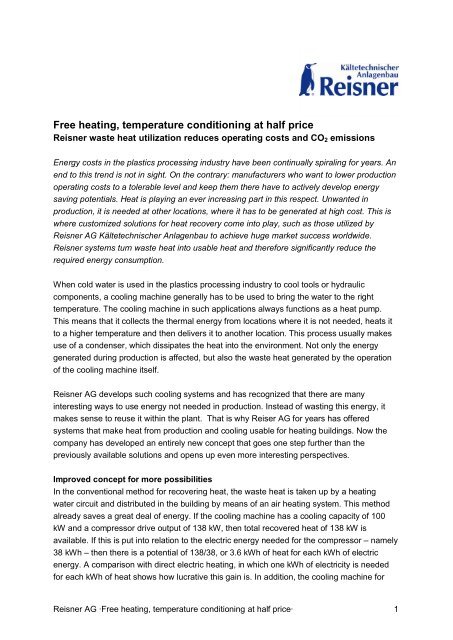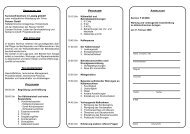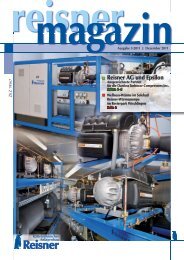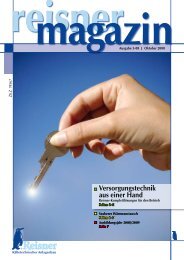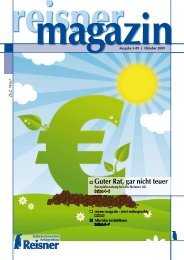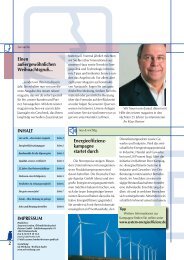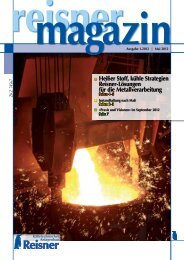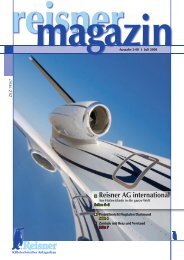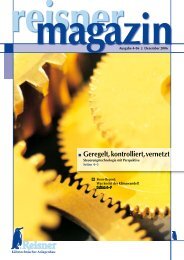Free heating, temperature conditioning at half price - Reisner AG
Free heating, temperature conditioning at half price - Reisner AG
Free heating, temperature conditioning at half price - Reisner AG
You also want an ePaper? Increase the reach of your titles
YUMPU automatically turns print PDFs into web optimized ePapers that Google loves.
<strong>Free</strong> <strong>he<strong>at</strong>ing</strong>, <strong>temper<strong>at</strong>ure</strong> <strong>conditioning</strong> <strong>at</strong> <strong>half</strong> <strong>price</strong><br />
<strong>Reisner</strong> waste he<strong>at</strong> utiliz<strong>at</strong>ion reduces oper<strong>at</strong>ing costs and CO2 emissions<br />
Energy costs in the plastics processing industry have been continually spiraling for years. An<br />
end to this trend is not in sight. On the contrary: manufacturers who want to lower production<br />
oper<strong>at</strong>ing costs to a tolerable level and keep them there have to actively develop energy<br />
saving potentials. He<strong>at</strong> is playing an ever increasing part in this respect. Unwanted in<br />
production, it is needed <strong>at</strong> other loc<strong>at</strong>ions, where it has to be gener<strong>at</strong>ed <strong>at</strong> high cost. This is<br />
where customized solutions for he<strong>at</strong> recovery come into play, such as those utilized by<br />
<strong>Reisner</strong> <strong>AG</strong> Kältetechnischer Anlagenbau to achieve huge market success worldwide.<br />
<strong>Reisner</strong> systems turn waste he<strong>at</strong> into usable he<strong>at</strong> and therefore significantly reduce the<br />
required energy consumption.<br />
When cold w<strong>at</strong>er is used in the plastics processing industry to cool tools or hydraulic<br />
components, a cooling machine generally has to be used to bring the w<strong>at</strong>er to the right<br />
<strong>temper<strong>at</strong>ure</strong>. The cooling machine in such applic<strong>at</strong>ions always functions as a he<strong>at</strong> pump.<br />
This means th<strong>at</strong> it collects the thermal energy from loc<strong>at</strong>ions where it is not needed, he<strong>at</strong>s it<br />
to a higher <strong>temper<strong>at</strong>ure</strong> and then delivers it to another loc<strong>at</strong>ion. This process usually makes<br />
use of a condenser, which dissip<strong>at</strong>es the he<strong>at</strong> into the environment. Not only the energy<br />
gener<strong>at</strong>ed during production is affected, but also the waste he<strong>at</strong> gener<strong>at</strong>ed by the oper<strong>at</strong>ion<br />
of the cooling machine itself.<br />
<strong>Reisner</strong> <strong>AG</strong> develops such cooling systems and has recognized th<strong>at</strong> there are many<br />
interesting ways to use energy not needed in production. Instead of wasting this energy, it<br />
makes sense to reuse it within the plant. Th<strong>at</strong> is why Reiser <strong>AG</strong> for years has offered<br />
systems th<strong>at</strong> make he<strong>at</strong> from production and cooling usable for <strong>he<strong>at</strong>ing</strong> buildings. Now the<br />
company has developed an entirely new concept th<strong>at</strong> goes one step further than the<br />
previously available solutions and opens up even more interesting perspectives.<br />
Improved concept for more possibilities<br />
In the conventional method for recovering he<strong>at</strong>, the waste he<strong>at</strong> is taken up by a <strong>he<strong>at</strong>ing</strong><br />
w<strong>at</strong>er circuit and distributed in the building by means of an air <strong>he<strong>at</strong>ing</strong> system. This method<br />
already saves a gre<strong>at</strong> deal of energy. If the cooling machine has a cooling capacity of 100<br />
kW and a compressor drive output of 138 kW, then total recovered he<strong>at</strong> of 138 kW is<br />
available. If this is put into rel<strong>at</strong>ion to the electric energy needed for the compressor – namely<br />
38 kWh – then there is a potential of 138/38, or 3.6 kWh of he<strong>at</strong> for each kWh of electric<br />
energy. A comparison with direct electric <strong>he<strong>at</strong>ing</strong>, in which one kWh of electricity is needed<br />
for each kWh of he<strong>at</strong> shows how lucr<strong>at</strong>ive this gain is. In addition, the cooling machine for<br />
<strong>Reisner</strong> <strong>AG</strong> ·<strong>Free</strong> <strong>he<strong>at</strong>ing</strong>, <strong>temper<strong>at</strong>ure</strong> <strong>conditioning</strong> <strong>at</strong> <strong>half</strong> <strong>price</strong>· 1
production of the cold w<strong>at</strong>er is oper<strong>at</strong>ing in any case and the waste he<strong>at</strong> is therefore<br />
available <strong>at</strong> no extra expense.<br />
Ventil<strong>at</strong>ion units distribute the<br />
he<strong>at</strong> to where it is needed.<br />
They can be adapted to<br />
specific room conditions.<br />
However, the standard technologies for he<strong>at</strong> recovery used in the past do not fully exhaust<br />
the potentials for saving. Some of the valuable energy is lost. Therefore, only <strong>he<strong>at</strong>ing</strong> w<strong>at</strong>er<br />
with a rel<strong>at</strong>ively low <strong>temper<strong>at</strong>ure</strong> can be supplied. This represents a limit<strong>at</strong>ion in the <strong>he<strong>at</strong>ing</strong><br />
of the plant. The low-<strong>temper<strong>at</strong>ure</strong> <strong>he<strong>at</strong>ing</strong> w<strong>at</strong>er can only be used for air duct and floor<br />
<strong>he<strong>at</strong>ing</strong> systems. If older <strong>he<strong>at</strong>ing</strong> radi<strong>at</strong>ors in offices and halls are used for <strong>he<strong>at</strong>ing</strong> to a<br />
comfortable <strong>temper<strong>at</strong>ure</strong>, the <strong>temper<strong>at</strong>ure</strong> of the w<strong>at</strong>er has to be much higher. In order to reuse<br />
energy directly in production and to gener<strong>at</strong>e he<strong>at</strong> by reusing waste he<strong>at</strong>, an even hotter<br />
<strong>he<strong>at</strong>ing</strong> medium is necessary. This applic<strong>at</strong>ion is especially <strong>at</strong>tractive, because <strong>temper<strong>at</strong>ure</strong><br />
<strong>conditioning</strong> units normally are oper<strong>at</strong>ed directly with electricity and only one kWh of he<strong>at</strong> can<br />
be gener<strong>at</strong>ed for each kWh of electricity.<br />
An effective cost-benefit r<strong>at</strong>io<br />
In the continued development of its he<strong>at</strong> recovery concept, an important focus for <strong>Reisner</strong><br />
<strong>AG</strong> was th<strong>at</strong> the w<strong>at</strong>er provided by the systems has to be as hot as possible. This can result<br />
in problems with efficiency, depending on the desired <strong>temper<strong>at</strong>ure</strong>: the system may have to<br />
achieve a higher condens<strong>at</strong>ion <strong>temper<strong>at</strong>ure</strong>. Consequently, the compressor requires more<br />
electric power. Therefore, not only the potential benefit of the he<strong>at</strong> recovery increases, but<br />
also the expense for achieving it – and this r<strong>at</strong>io has to be considered for each individual<br />
solution.<br />
The method applied by <strong>Reisner</strong> <strong>AG</strong> is based on the perfect control of all thermodynamic<br />
processes in the system. This makes it possible to minimize losses and to utilize nearly one<br />
hundred percent of the waste he<strong>at</strong>. High <strong>he<strong>at</strong>ing</strong> medium <strong>temper<strong>at</strong>ure</strong>s can also be achieved<br />
without necessarily having to increase the condens<strong>at</strong>ion <strong>temper<strong>at</strong>ure</strong>. This limits the power<br />
consumption of the cooling system. A key technical concept is the central bundling of the<br />
waste he<strong>at</strong> stream. This is achieved by installing a <strong>he<strong>at</strong>ing</strong> circuit th<strong>at</strong> circul<strong>at</strong>es through the<br />
condenser and collects all of the waste he<strong>at</strong>. If not all of the he<strong>at</strong> is needed – for example, if<br />
it is to be used for <strong>he<strong>at</strong>ing</strong> purposes and the outside <strong>temper<strong>at</strong>ure</strong> is high enough th<strong>at</strong> no<br />
<strong>Reisner</strong> <strong>AG</strong> ·<strong>Free</strong> <strong>he<strong>at</strong>ing</strong>, <strong>temper<strong>at</strong>ure</strong> <strong>conditioning</strong> <strong>at</strong> <strong>half</strong> <strong>price</strong>· 2
Efficient all-rounder: this<br />
<strong>Reisner</strong> cooling system is<br />
optimized for use with he<strong>at</strong><br />
recovery.<br />
<strong>he<strong>at</strong>ing</strong> is necessary – a dry cooler dissip<strong>at</strong>es the he<strong>at</strong> into the environment. Otherwise, the<br />
<strong>he<strong>at</strong>ing</strong> medium stream is bundled in a special tank, where the waste he<strong>at</strong> is stored and can<br />
easily be tapped for the respective applic<strong>at</strong>ion. The he<strong>at</strong> exchangers used in the system are<br />
also important. They are designed especially for he<strong>at</strong> recovery and therefore achieve<br />
optimum results.<br />
Convincing figures<br />
The success of this concept is demonstr<strong>at</strong>ed by numerous reference systems from <strong>Reisner</strong>:<br />
Dr. Schneider Kunststoffwerke GmbH, loc<strong>at</strong>ed in Kronach in Bavaria, even implemented the<br />
conversion of its cooling unit to a waste he<strong>at</strong> recovery system as a pilot project sponsored by<br />
the Federal Ministry for the Environment and Conserv<strong>at</strong>ion. At the Russian plant of the<br />
window profile manufacturer Deceuninck the <strong>Reisner</strong> system provides for fully adequ<strong>at</strong>e<br />
<strong>he<strong>at</strong>ing</strong> of the building despite extreme winter <strong>temper<strong>at</strong>ure</strong>s – with no additional energy<br />
costs. The surface finishing specialist Vollmerhaus of Plettenberg also now benefits from the<br />
free available he<strong>at</strong> energy with the help of a <strong>Reisner</strong> system.<br />
Large halls can also be<br />
he<strong>at</strong>ed easily with free<br />
available he<strong>at</strong>.<br />
Even with a cooling unit with a cooling capacity of 155 kW and a compressor capacity of 42<br />
kW – therefore with total waste he<strong>at</strong> of 197 kW – the he<strong>at</strong> recovery is sufficient to he<strong>at</strong> an<br />
area of 2,500 sq. meters all winter long – <strong>at</strong> no additional cost. The effect on the company’s<br />
overall energy costs is demonstr<strong>at</strong>ed concretely by converting the efficiency of the system<br />
<strong>Reisner</strong> <strong>AG</strong> ·<strong>Free</strong> <strong>he<strong>at</strong>ing</strong>, <strong>temper<strong>at</strong>ure</strong> <strong>conditioning</strong> <strong>at</strong> <strong>half</strong> <strong>price</strong>· 3
into fuel oil saved. The system has a calorific value of 9 kWh per liter. The estim<strong>at</strong>ed waste<br />
he<strong>at</strong> stream of 197 kW is therefore equivalent to 21.9 liters of fuel oil per hour. If a liter of fuel<br />
oil costs 0.60 EUR, then <strong>he<strong>at</strong>ing</strong> the hall with waste he<strong>at</strong> saves more than 13 EUR for each<br />
hour of oper<strong>at</strong>ion as compared with oil <strong>he<strong>at</strong>ing</strong>. Therefore, the amortiz<strong>at</strong>ion period for the<br />
additional investment for the he<strong>at</strong> recovery is certain to be short, especially in view of the<br />
prospect of continuing increases in oil <strong>price</strong>s.<br />
Temper<strong>at</strong>ure <strong>conditioning</strong> units on injection molding machines can often be oper<strong>at</strong>ed by<br />
means of waste he<strong>at</strong>. However, this applic<strong>at</strong>ion generally requires an especially high <strong>he<strong>at</strong>ing</strong><br />
medium <strong>temper<strong>at</strong>ure</strong> of <strong>at</strong> least 60°C. Such <strong>temper<strong>at</strong>ure</strong>s cannot always be achieved simply<br />
by the use of the existing waste he<strong>at</strong>. A higher condens<strong>at</strong>ion <strong>temper<strong>at</strong>ure</strong> is necessary; the<br />
compressor uses more electric energy and the energy efficiency r<strong>at</strong>ing of the system drops.<br />
Nevertheless, the use of waste he<strong>at</strong> can also be very worthwhile in this case. If, for example,<br />
w<strong>at</strong>er with a <strong>temper<strong>at</strong>ure</strong> of 60°C is to be provided by the 155 kW cooling unit from our<br />
example above, the output of the system drops to 123 kW. At the same time, the energy<br />
consumption increases to about 67 kW. This results in a total thermal output of 190 kW<br />
which is available for the <strong>temper<strong>at</strong>ure</strong> <strong>conditioning</strong> units. Oper<strong>at</strong>ed with electricity, the r<strong>at</strong>io of<br />
expended energy to gener<strong>at</strong>ed energy would be 1:1; therefore, the oper<strong>at</strong>ing costs would be<br />
nearly cut in <strong>half</strong> in this example.<br />
Severe winters, zero<br />
<strong>he<strong>at</strong>ing</strong> costs. It can be<br />
done – with the <strong>Reisner</strong><br />
system, which converts<br />
Despite all the possibilities resulting from the new he<strong>at</strong> recovery concepts, <strong>Reisner</strong> never<br />
loses sight of the fact th<strong>at</strong> the core function of their systems is cooling. The main goal here is<br />
always to achieve outstanding energy efficiency r<strong>at</strong>ings. After all, the cooling system is<br />
needed for production anyway and has to be integr<strong>at</strong>ed in the production process to the<br />
fullest extent possible. Th<strong>at</strong> also has to be considered in amortiz<strong>at</strong>ion calcul<strong>at</strong>ions, which<br />
should estim<strong>at</strong>e only the additional expense for the waste he<strong>at</strong> utiliz<strong>at</strong>ion.<br />
<strong>Reisner</strong> <strong>AG</strong> ·<strong>Free</strong> <strong>he<strong>at</strong>ing</strong>, <strong>temper<strong>at</strong>ure</strong> <strong>conditioning</strong> <strong>at</strong> <strong>half</strong> <strong>price</strong>· 4
As with any system, it is important th<strong>at</strong> the cooling system with he<strong>at</strong> recovery also be<br />
adapted fully to oper<strong>at</strong>ional requirements. This is necessary in order for the <strong>Reisner</strong> system<br />
to be fully effective: the waste he<strong>at</strong> is utilized 100 percent and the electric power<br />
consumption of the cooling machine changes only minimally as compared with normal<br />
oper<strong>at</strong>ion. This guarantees a future-sustainable supply of cold and he<strong>at</strong>, which will<br />
permanently keep pace with the increasingly stringent clim<strong>at</strong>e protection laws and<br />
successfully turn back spiraling oper<strong>at</strong>ing costs.<br />
<strong>Reisner</strong> <strong>AG</strong> ·<strong>Free</strong> <strong>he<strong>at</strong>ing</strong>, <strong>temper<strong>at</strong>ure</strong> <strong>conditioning</strong> <strong>at</strong> <strong>half</strong> <strong>price</strong>· 5


